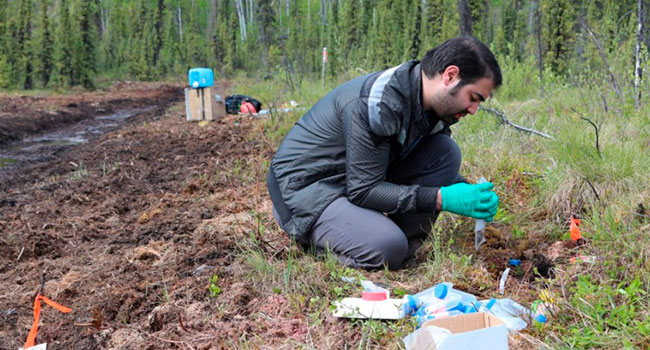The researchers compared the microbial communities found in permafrost formed during the last ice age, at the end of the geological epoch known as the Pleistocene, with those at the beginning of the modern era, known as the Holocene.
“We found that both the microbial communities and the chemical parameters are stable within each era until they cross a threshold, driven by the change in climate,” explained study co-author Brian Lanoil, an associate professor in the Faculty of Science.
“After that threshold, there is an abrupt switch to a new microbial community and new soil chemistry. We argue that modern climate change could lead to a similar transition in state for soils in Arctic ecosystems, with unknown consequences.”
The researchers hypothesize that this change in soil may create a new soil profile unfavourable to existing microbial communities, with widespread effects.
“Since soils are where plants grow and where nearly all terrestrial life lives, this could have big impacts on the entire Arctic ecosystem,” explained Lanoil. “Our work shows this happened before, and it is possible that this could happen again as the result of current climate change.”
| RELATED CONTENT |
| New soil database will help Alberta farmers plot out sustainable practices By Bev Betkowski |
| New research will map out how much carbon prairie soil is storing By Bev Betkowski |
| What the heck are jumping worms? By Geoff Carpentier |
Soil microbes are important for many ecosystem functions, and drastic changes to the microbe community may lead to many changes in how those soils function. For instance, microbes in the current environment are responsible for processing carbon and nitrogen, and a change in these systems could have the potential to affect carbon and nitrogen cycles in Arctic ecosystems.
But Lanoil noted further research is needed to better understand the function of new microbial communities that form after crossing the threshold and their potential effects on the wider ecosystem.
“Our findings may also explain the reason behind the contradictory results obtained from field and laboratory soil warming experiments,” added PhD student Alireza Saidi-Mehrabad, lead author on the study. “This difference is likely because field-based studies involve moderate heating of the soil. In contrast, in laboratory-based incubations, a small amount of permafrost thaw could result in rapid response to increased temperature, leading to major changes in both soil chemistry and microbial community structure.”
Other collaborators on this research include Duane Froese, professor in the Faculty of Science and Canada Research Chair in Northern Environmental Change; Patrick Neuberger, former graduate student in the Lanoil lab; and Morteza Hajihosseini, graduate student in the U of A’s School of Public Health.
| By Kate Willis
| By [WRITER’S NAME]
Kate is a reporter with the University of Alberta’s Folio online magazine. The University of Alberta is a Troy Media Editorial Content Provider Partner.
The opinions expressed by our columnists and contributors are theirs alone and do not inherently or expressly reflect the views of our publication.
© Troy Media
Troy Media is an editorial content provider to media outlets and its own hosted community news outlets across Canada.



